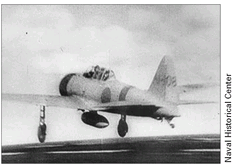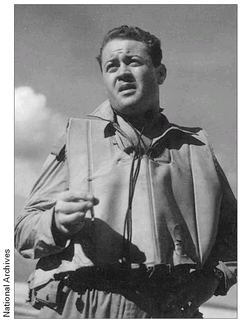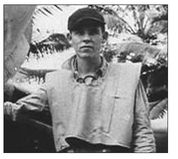War Stories II (40 page)
Authors: Oliver L. North

The raid by seventy Zekesâthe latest version of the infamous Zeroâand twenty-four heavy bombers was a disaster. All but one of Koga's planes was downedâat a cost of four American and two New Zealand fighters.
The disastrous June air raid on Guadalcanal had another unanticipated adverse consequence for Admiral Koga besides the loss of his planes and pilots. It convinced Halsey that it was time to get moving northâup the Solomonsâto wrest the fortress of Bougainville from Japanese control. But first he had to eliminate two enemy air bases that threatened his advance: one at Munda on New Georgia Island and the other at Vila on nearby Kolombangara Island.
On 30 June, Admiral Turner, commanding the 3rd Amphibious Force, landed 6,000 Marines and soldiers on New Georgia and promptly seized the Munda airstrip. The Seabees followed immediately to patch the runway, and the first American aircraft prepared to land on the captured airstrip within seventy-two hours of the landing. But it didn't go as planned.
The plan called for a quick clearing operation and then an attack to seize the airstrip at Vila, on Kolombangara, less than ten miles away across the Kula Gulf. But just as on Guadalcanal, the bottom fell out of Turner's timetable.
The 4,500 well-entrenched Japanese troops on New Georgia might have lost their airstrip, but they weren't about to give up. The dogged defenders held on for more than a monthârequiring the commitment of 32,000 soldiers and 1,700 Marines. And, as was becoming the custom, those Japanese troops who couldn't be evacuated by the Tokyo Express fought to the last man.
That was enough to convince Halsey that he should skip the heavily defended Vila airdrome and seize the lightly held Japanese island of Vella Lavella, fifty miles to the north. On 14 August, 6,000 troops from New Georgia were backloaded onto waiting amphibious ships and landed the following morning on the southwest coast of Vella Lavella. Once again the Seabees rushed ashore and in a matter of forty-eight hours constructed a rough but functional fighter strip. As soon as they finished, Marine, Army and Navy aircraft came winging in to protect the troops ashore and the ships of the amphibious force.
The Americans were finally on the move toward Rabaul. Though Nimitz, MacArthur, and Halsey realized that there were long and difficult battles ahead, there was no longer any doubt that U.S. superiority on the sea and in the air were essential ingredients for successful operations on the ground.
By the summer of 1943, U.S. air superiority could be measured in both quantity and quality. Army, Navy, and Marine air training commands had quadrupled the output of pilots, navigators, gunners, bombardiers, mechanics, and air crewmen from the levels achieved in 1942. In that same time frame, the production of new and better aircraft had increased seven-fold.
The quantitative and qualitative edge the Japanese had enjoyed the previous year was now gone.
The quantitative and qualitative edge the Japanese had enjoyed the previous year was now gone.
For the first months of the war, the Mitsubishi A6M
Reisen
, or “Zero,” ruled the skies over the Pacific. These planes were light, fast, and were also equipped with heavy armamentâtwo 20 mm cannons and a pair of 7.7 mm nose-mounted machine guns.
Reisen
, or “Zero,” ruled the skies over the Pacific. These planes were light, fast, and were also equipped with heavy armamentâtwo 20 mm cannons and a pair of 7.7 mm nose-mounted machine guns.
The Zero was a proven plane, having been battle-tested in China for more than a year before the first ones appeared in the skies over Pearl Harbor on 7 December 1941. It had proven itself superior to any other aircraft in China, Burma, the Philippines, and the Dutch East Indies.
So too had most of the Japanese pilots, many of whom had ten years of combat experience. The age of the average American pilot was nineteen.
A typical Zero pilot wore a parachute and a harness and carried a small pistolânot for personal protection but as a “suicide weapon.” In the Japanese warrior tradition it was dishonorable to be captured or to surrenderâsuicide was preferable to the dishonor of defeat or surrender.
But the Japanese no longer ruled the skies. By the spring of 1943 Army P-38s and Marine Chance-Vought F4U Corsairs were being delivered in significant numbers. The Marines inherited the powerful, gull-winged fighters from the Navy when a landing gear problem caused the F4U to fail its aircraft carrier qualification. Though the Corsair was not as maneuverable as the Zero, the Marines loved it for its powerful rate of climb and firepower. Corsair pilots called it “Hog Nose” for its massive front cowling. It was powered by a 2,000-horsepower supercharged radial engineânearly twice the horsepower of the Zero. And with six .50-caliber machine guns in the wings, the Corsair was also better armed.
Â
The
Reisen
or “Zero.”
Reisen
or “Zero.”

As Halsey started island-hopping up the Solomons in the summer of 1943, Marine Fighter Squadron VMF-214âflying their new Corsairsâ
became a key component in the successful drive. The squadron was commanded by a scrappy, thirty-one-year-old Marine combat pilot named Gregory Boyington. Born in Coeur d'Alene, Idaho, Boyington had received his commission and as an aviation cadet served in the Marines. But in August of 1941 he resigned his commission to join Claire Chennault's Air Volunteer Group in China, the Flying Tigers. The pay was good and the pilots got a $500 bonus for every confirmed kill.
became a key component in the successful drive. The squadron was commanded by a scrappy, thirty-one-year-old Marine combat pilot named Gregory Boyington. Born in Coeur d'Alene, Idaho, Boyington had received his commission and as an aviation cadet served in the Marines. But in August of 1941 he resigned his commission to join Claire Chennault's Air Volunteer Group in China, the Flying Tigers. The pay was good and the pilots got a $500 bonus for every confirmed kill.
In his autobiography,
Baa Baa Black Sheep
, Boyington claimed to have shot down six aircraft while with the Flying Tigers. But the official records state that he had only two aerial victories that could be documented. Boyington argued that he should have been paid for the four enemy planes he had destroyed while they were sitting on the tarmac at a Japanese-held air base in China.
Baa Baa Black Sheep
, Boyington claimed to have shot down six aircraft while with the Flying Tigers. But the official records state that he had only two aerial victories that could be documented. Boyington argued that he should have been paid for the four enemy planes he had destroyed while they were sitting on the tarmac at a Japanese-held air base in China.
Â
Pappy Boyington led the Black Sheep Squadron.

It may have been after his stint with the Flying Tigers that someone came up with the nickname “Pappy.” At thirty-one, he was one of the “old” men of the unit. But he also had another nicknameâ“Black Sheep”âwhich he earned with the Flying Tigers. General John Alison said, “He was a liability. He lost airplanes; he got lost, landed wheels up . . . and, well, you know what Pappy's problem was? He drank too much. Chennault sent him back to the United States. He got a commission as a Marine major in the reserves, and was sent overseas in January of 1943.”
The decision on who should command the newly constituted VMF-214 Marine squadron fell to the assistant commanding general of the 1st Marine Air Wing, Brigadier General James “Nuts” Moore. Major Boyington landed on Espiritu Santo about when General Moore was trying to make that decision.
Perhaps more on the basis of his tenure as a combat pilot than for his spotty record with the Flying Tigers, Major Boyington was picked as CO of VMF-214.
Perhaps more on the basis of his tenure as a combat pilot than for his spotty record with the Flying Tigers, Major Boyington was picked as CO of VMF-214.
Now the squadron needed a new name. The men in the squadron submitted all kinds of names, including a few that were outright profane. The Marine public information office did their best to discourage those, reminding the men that it would prevent them from sending news releases to hometown newspapers publicizing their exploits. How could they do that with a squadron name they couldn't print in a family newspaper?
Eventually common sense took over and the name of VMF-214 became the “Black Sheep Squadron.” The pilots of VMF-214 were combat-trained by Pappy Boyington. What his green pilots lacked in seat time they made up in strategies, taught to them by their leader in colorful sessions on the ground. In earthy, blunt terms, he preached to them, “Whenever you see a Japanese plane, kill it. That's our mission. Pick one out and kill it.”
The Black Sheep Squadron did just as they were ordered. Their first mission was to fly escort for twelve B-24s on a bombing run to Kahili.
The flight turned into a pitched battle with Japanese Zeros, covering some 200 miles of sea and airspace during a brief forty-five minutes. When it was over, sixteen of the twenty-four Black Sheep fighter pilots had seen combat action for the very first time.
The squadron claimed eleven Japanese planes downed in the battle that day, with Pappy getting the credit for five of those kills. In their first month of combat, the Black Sheep Squadron was credited with fifty-seven kills and nineteen “probables,” and their fame grew. And so did the pressure on Pappy Boyington to get even more victories. During the next three months under Boyington, the unit claimed ninety-four enemy aircraft shot down.
On 15 August, Halsey's amphibious forces, aided by the Black Sheep Squadron flying cover, landed on small Vella Lavella Island, where the Seabees immediately went to work building the airstrip that would become the newest forward air base for VMF-214.
Lieutenant John “Jack” Bolt, a twenty-three-year-old aviator and instructor from Florida, had been flying combat missions over the
Solomons since May. Two Marine aviators, Lieutenants Henry “Hank” McCartney and Henry “Boo” Bourgeois, just a year younger than Bolt, arrived about the same time.
Solomons since May. Two Marine aviators, Lieutenants Henry “Hank” McCartney and Henry “Boo” Bourgeois, just a year younger than Bolt, arrived about the same time.

LIEUTENANT HENRY MCCARTNEY, USMC
Solomon Islands
18 September 1943
1530 Hours Local
Solomon Islands
18 September 1943
1530 Hours Local

Guadalcanal was no fun. Munda was no fun either. Living on Munda was miserable. There was no place to take a shower or a bath. The guys would go down to a creek close by. The only tour in which I thought we had halfway decent living conditions was the tour I spent on the Russell Islands.
Our friends in the Marine artillery had a 105 right up in back of my tent. And they'd do harassing fire against the Japs. Of course, every time they'd fire that thing off, we'd come up out of the sack. And it was difficult to get a good night's sleep.
So one of the very first mutinies at Guadalcanal was the fighter pilots going down to Operations. They said, “Get that artillery gun out, or you won't have any fighter pilots.” They moved it.
I came into the squadron January of '43, with four kills to my credit. I may have had more than Pappy at that time. All together, I'm credited with five and a half, and three probables.
Our first combat tour with 214 was relatively quiet. When they came back from the second tour, that's when they developed the concept of the fighter sweeps and there were more enemy aircraft challenging us. That's when our scores went up.
Other books
The Windup Girl by Paolo Bacigalupi
Weekend Lover by Melissa Blue
BREAKAWAY (The Dartmouth Cobras) by Sommerland, Bianca
The Book of Phoenix by Nnedi Okorafor
The Desperate Deputy of Cougar Hill by Louis Trimble
One Heart by Jane McCafferty
The Half Life by Jennifer Weiner
The Bride of Larkspear by Sherry Thomas
Your Captivating Love by Layla Hagen
